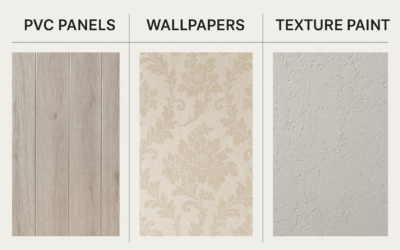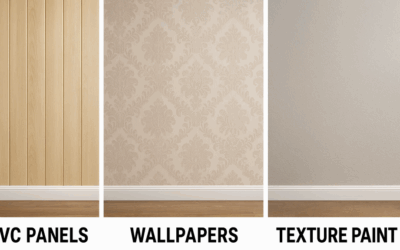False ceilings, also known as suspended ceilings, are becoming a staple in modern interior design. These ceilings not only enhance the overall aesthetics of a room but also offer practical benefits such as insulation, noise reduction, and hiding unsightly wiring or beams.
If you’re considering installing a false ceiling in your home, it’s important to understand the various options available, such as Gypsum and POP (Plaster of Paris) ceilings, along with their cost implications, durability, and the ambiance they create. This guide will help you make an informed decision based on your needs and preferences.
What is a False Ceiling?
A false ceiling is a secondary ceiling structure suspended beneath the main ceiling. It is installed using metal frames and can be made from a variety of materials, including gypsum, plaster, wood, and mineral fiber. False ceilings are popular in both residential and commercial spaces, offering aesthetic versatility and practical functionality.
Types of False Ceilings
The most commonly used materials for false ceilings are Gypsum and POP (Plaster of Paris). Let’s take a closer look at these options:
Gypsum False Ceilings
Gypsum is a versatile and widely used material for creating false ceilings. It is made from a natural mineral compound, offering several advantages in terms of installation, cost, and performance.
Pros:
- Cost-Effective: Gypsum ceilings are relatively affordable compared to other ceiling materials. They offer a good balance between cost and quality.
- Lightweight and Easy to Install: Gypsum boards are lightweight and easy to handle, making them quicker to install. This helps in reducing the overall installation cost.
- Fire-Resistant: Gypsum is inherently fire-resistant, making it a safer choice, especially for kitchens, living rooms, and areas where fire safety is a priority.
- Sound Insulation: Gypsum ceilings offer excellent sound insulation, reducing noise pollution between rooms, which is great for bedrooms and home offices.
- Versatility: Gypsum can be moulded into various shapes and designs, including sleek, modern, or traditional patterns.
Cons:
- Less Durable in High Humidity: Gypsum is not ideal for areas with high moisture levels, such as bathrooms or kitchens, unless specifically treated with anti-moisture coatings.
- Cracking Over Time: While durable, gypsum boards can develop cracks after prolonged use, especially if the installation wasn’t done properly.
Cost of Gypsum False Ceilings:
The cost of gypsum ceilings typically ranges between ₹50 to ₹100 per square foot, depending on the thickness, design, and installation complexity. The overall cost will also include the cost of labour, which can add another ₹15 to ₹30 per square foot.
2. POP (Plaster of Paris) False Ceilings
POP false ceilings are another popular choice. Plaster of Paris is a quick-drying material made by heating gypsum, resulting in a fine white powder. This powder is then mixed with water to form a smooth, moldable substance.
Pros:
● Highly Customizable: POP ceilings can be moulded into intricate designs, offering maximum flexibility in terms of shape and style. Whether you’re looking for a minimalist or ornate design, POP can accommodate it.
● Superior Finish: POP finishes tend to be smoother and more refined compared to other materials, offering a flawless look.
● Durable: POP is highly durable when installed correctly. It can last for several years without significant wear and tear, making it a long-lasting option.
● Sound Absorption: Like gypsum, POP ceilings are excellent at absorbing sound, reducing noise from external sources.
● Low Maintenance: POP ceilings are easy to maintain and can be cleaned with a damp cloth.
Cons:
● Time-Consuming Installation: POP ceilings are more time-consuming to install compared to gypsum because the material has to be mixed and applied layer by layer.
● Prone to Cracks in Extremes: Although durable, POP can crack over time due to shifting temperatures, humidity, or poor installation techniques.
● Heavy Material: POP can be heavier than gypsum, which means the structural frame needs to be stronger to support the weight.
Cost of POP False Ceilings:
POP ceilings are generally more expensive than gypsum ceilings. The cost ranges between ₹70 to ₹150 per square foot, depending on the intricacy of the design, material quality, and labour.
Comparing Gypsum and POP False Ceilings
Cost Comparison:
● Gypsum: ₹50 to ₹100 per sq. ft.
● POP: ₹70 to ₹150 per sq. ft.
Durability:
● Gypsum: Less durable in humid conditions, but offers a decent lifespan with proper maintenance.
● POP: Highly durable and can withstand wear and tear, but susceptible to cracking under extreme conditions.
Aesthetic Flexibility:
● Gypsum: Offers limited design options but can be moulded into basic shapes.
● POP: Offers extensive design flexibility, ideal for complex and customized ceiling designs.
Sound Insulation:
Both materials offer soundproofing benefits, but gypsum is generally considered slightly better due to its denser structure.
False Ceilings and Ambience: How They Impact Your Home’s Look
One of the primary reasons homeowners choose false ceilings is the ambiance they help create. The right ceiling can completely transform the feel of a room. Here’s how different types of false ceilings can impact your home:
Aesthetic Appeal:
False ceilings can add drama and elegance to a room. Whether it’s a pop design in the living room or subtle grooves in the bedroom, a false ceiling enhances the visual appeal of any space.
● Gypsum Ceiling: Works well in both contemporary and classic designs. You can create linear or curved shapes to suit your taste.
● POP Ceiling: Offers infinite design possibilities, from simple to elaborate designs. You can add false beams, patterns, or even integrate lighting fixtures for a more dramatic effect.
Light Integration:
False ceilings are perfect for integrating lighting. You can install LED strip lights, chandeliers, and recessed lighting into the false ceiling, allowing you to control the lighting intensity and create the perfect mood.
● Gypsum Ceiling: Best for creating sleek, minimalist designs with embedded lighting.
● POP Ceiling: Ideal for integrating intricate lighting designs, creating a luxurious, high-end look.
Temperature Control and Insulation:
False ceilings also provide insulation against heat and cold. They create an air pocket between the ceiling and the room, which helps in regulating indoor temperatures.
● Gypsum Ceiling: Provides a moderate level of insulation, making it ideal for temperate climates.
● POP Ceiling: Offers superior insulation, ideal for homes in regions with extreme weather conditions.
Conclusion: Which False Ceiling Should You Choose?
Both gypsum and POP ceilings come with their own set of advantages and challenges. The choice ultimately depends on your budget, desired aesthetic, and the practical needs of the space. Here’s a quick decision guide:
● Go for Gypsum if you want a cost-effective, lightweight, and fire-resistant ceiling with decent soundproofing.
● Opt for POP if you prefer a durable, customizable, and luxurious finish with advanced design options.
For new homeowners looking to add a touch of sophistication and style to their home, false ceilings are a great investment. Whether you opt for the affordability of gypsum or the intricate elegance of POP, the right false ceiling will enhance the ambiance and functionality of your home for years to come.
Explore more options at Frentko for modular home interiors and modular kitchens that can complement your ceiling designs.




0 Comments